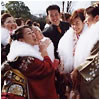Learn About Japan > Japan Through the Year > Public Holidays > National Foundation Day or Kigensetsu (February 11)

|

Public Holidays
- New Year's Day or Shōgatsu (January 1)
- Coming-of-Age Day (second Monday in January)
- National Foundation Day or Kigensetsu (February 11)
- Spring Equinox Day or Vernal Equinox (March)
- Golden Week (Late April-Early May)
- Marine Day (Third Monday in July)
- Respect-for-the-Aged Day (Third Monday in September)
- Autumnal Equinox Day (September)
- Culture Day (November 3)
- Labor Thanksgiving Day (November 23)
- Emperor’s Birthday (December 23)
|

The Japanese national flag, the Hinomaru, flies on National Foundation Day
Photo Courtesy of Hana World
National Foundation Day or Kigensetsu (February 11)
National Foundation Day was called Kigensetsu in the Meiji Era. This holiday celebrated the enthronement on this day in 660 B.C of the Emperor Jimmu, the mythological first emperor of Japan.
Kigensetsu celebrated the foundation of the imperial family. Until the end of World War II, the government held the myth of Emperor Jimmu to be historical fact, so this was regarded as one of the most important national holidays. When the role of the Emperor and the history of Japan were reconsidered in the post-war democratization, kigensetsu as a national holiday was abolished. However, in 1966, after repeated proposals and terminations of the bill in the Diet, National Foundation Day was added as a national holiday. The Japanese Holiday Law defines this day as a holiday for Japanese people to “think of the foundation of the nation and cultivate love for the nation.”
|
|
|
| Download Podcast in
English
| Japanese
|
|
Document |
Audio-Video |
Chart |
Picture |
Map
|
|

